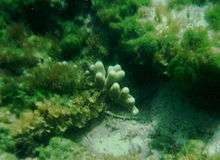Porites
| Finger Coral | |
|---|---|
| | |
| Porites sp. | |
| Scientific classification | |
| Kingdom: | Animalia |
| Phylum: | Cnidaria |
| Class: | Anthozoa |
| Order: | Scleractinia |
| Suborder: | Fungiina |
| Family: | Poritidae |
| Genus: | Porites Link, 1807[1] |
| Species | |
|
See text | |
| Synonyms | |
|
Synaraea Verrill, 1864[2] | |
Porites is a genus of stony coral; they are SPS (Small Polyp Stony) corals. They are characterised by a finger-like morphology. Members of this genus have widely spaced calices, a well-developed wall reticulum and are bilaterally symmetrical. Porites, particularly Porites lutea, often form microatolls.[3] Corals of the genus Porites also often serve as hosts for Christmas tree worms (Spirobranchus giganteus).
Aquarium trade
Specimens of Porites are sometimes available for purchase in the aquarium trade. Most Porites that are collected have Christmas tree worms (Spirobranchus giganteus) that bore into the coral, serving as additional aesthetic livestock. These particular Porites specimens are called "christmas tree worm rocks" or "christmas tree worm coral". However, due to the strict water quality, lighting and dietary requirements, keeping Porites in captivity is very difficult.

Paleoclimatology
Porites corals have been shown to be accurate and precise recorders of past marine surface conditions.[4] Measurements of the oxygen isotopic composition of the aragonitic skeleton of coral specimens indicate the sea-surface temperature conditions and the oxygen isotopic composition of the seawater at the time of growth.[5] The oxygen isotopic composition of seawater can indicate the precipitation/evaporation balance because oxygen atoms of the more abundant mass 16 will preferentially evaporate before the more rare mass 18 oxygen. The relationship between temperature, precipitation, and the oxygen isotopic composition of Porites corals is important for reconstructing past climates, and associated large-scale patterns such as the El-Nino Southern Oscillation, the Intertropical Convergence Zone, and the mean state of the climate system.
Ecology
Corals in the genus Porites are found in reefs throughout the world. It is a dominant taxon on the Pandora platform of the Great Barrier Reef. Potts et al. (1985) identified 7 dominant species: P. lobata, P. solida, P. lutea, P. australiensis, P. mayeri, P. murrayensis, and P. anae. The oldest of six colonies in this reef was approximately 700 years old, and was estimated to be growing at 10.3 mm per year.[6]
Meyer and Schultz (1985) demonstrated that P. furcata has a mutualistic relationship with the schools of French and White Grunts (Haemulon flaviolineatum and H. plumieri) that rest in their heads during the day. The fish provide it with ammonium, nitrates, and phosphorus compounds. Coral heads with resting grunts experience significantly higher growth rates and nitrogen composition than those without.[7]
Physiology
Some species in this genus demonstrate high levels of halotolerance. In the Gulf of Thailand P. lutea tolerates daily tidal shifts of 10-30‰ salinity. Moberg et al. (1997) determined that when the salinity declines, the symbiotic zooxanthellae decrease their photosynthesis rate as the coral contracts its polyps to protect them. The corals maintain their metabolic rate by temporarily switching to heterotrophy, consuming prey such as brine shrimp and other zooplankton.[8]
Porites growth rates can be determined by examining annual rings in their skeleton. This method was used to determine that P. astreoides grows its skeleton about the central axis by approximately 3.67mm/year, calcifies at approximately 0.55g/cm²/year, and increases density in this region of the body at approximately 1.69g/cm³/year.[9] Additionally, Meyer and Schultz (1985) reported that coral growth varies seasonally. They observed that P. furcata's growth rate peaked between May and August, which is summertime in their Caribbean habitat.[10]
Threats
Threats to corals in the genus Porites include predation, climate change, and anthropogenic pollution. When exposed to increased temperatures and copper, P. cylindrica slowed its rate of production. Additionally, the symbiotic zooxanthellae reduced their photosynthesis rate when exposed to both stressors.[11]
Done and Potts (1992) observed that when settled, larvae in Porites are vulnerable to competition from other corals and predation from sea urchins. Additionally, mortality likelihood increases following strong storms.[12]
Species
|
|
References
- ↑ WoRMS (2010). "Porites Link, 1807". World Register of Marine Species. Retrieved 2011-12-15.
- ↑ "ITIS Standard Report Page: Porites". Retrieved 2011-12-15.
- ↑ Flora, C.J.; Ely P.S. (2003). "Surface Growth Rings of Porites lutea Microatolls Accurately Track Their Annual Growth" (PDF). Northwest Science. 77 (3): 237–245. Retrieved 2009-10-30.
- ↑ http://onlinelibrary.wiley.com/doi/10.1002/wcc.39/pdf
- ↑ http://onlinelibrary.wiley.com/doi/10.1029/2011GL048224/pdf
- ↑ Potts, D.C.; Done, T.J.; Isdale, P.J.; Fisk, D.A. (1985). "Dominance of a Coral Community in the Genus Porites Scleractinia". Marine Ecology Progress Series. 23 (1): 79–84. doi:10.3354/meps023079.
- ↑ Meyer, J.L.; Schultz, E.T. (1985). "Tissue Condition and Growth Rate of Corals Associated with Schooling Fish". Limnol. Oceanogr. 30 (1): 157–166. doi:10.4319/lo.1985.30.1.0157.
- ↑ Moberg, F.; Nystrom, M.; Kautsky, N.; Tedengren, M.; Jarayabhand, P. (1997). "Effects of reduced salinity on the rates of photosynthesis and respiration in the hermatypic corals Porites lutea and Pocillopora damicornis". Marine Ecology Progress Series. 157: 53–59. doi:10.3354/meps157053.
- ↑ Elizalde-Rendon, E.M.; Horta-Puga, G.; Gonzalez-Diaz, P.; Carricart-Ganivet, J.P. (2010). "Growth characteristics of the reef-building coral Porites astreoides under different environmental conditions in the Western Atlantic". Coral Reefs. 29 (3): 607–614. doi:10.1007/s00338-010-0604-7.
- ↑ Meyer, J.L.; Schultz, E.T. (1985). "Tissue Condition and Growth Rate of Corals Associated with Schooling Fish". Limnol. Oceanogr. 30 (1): 157–166. doi:10.4319/lo.1985.30.1.0157.
- ↑ Nystrom, M.; Nordemar, I.; Tedengren, M. (2001). "Simultaneous and sequential stress from increased temperature and copper on the metabolism of the hermatypic coral Porites cylindrica". Marine Biology (Berlin). 138 (6): 1225–1231.
- ↑ Done, T.J.; Potts, D.C. (1992). "Influences of habitat and natural disturbances on contributions of massive Porites corals to reef communities". Marine Biology (Berlin). 114 (3): 479–493. doi:10.1007/BF00350040.